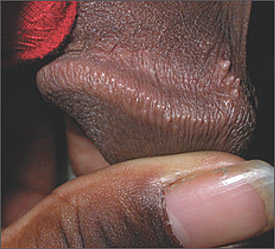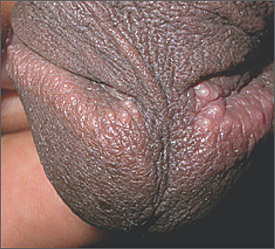
Am Fam Physician. 2006;73(3):519-520
A 19-year-old black man presented with a history of “white spots” that had been on his penis for “a while” (Figures 1 and 2). Other than their presence, the lesions were entirely asymptomatic—specifically, there was no pain, pruritus, or purulence. He had no ongoing health problems, was on no medications, and had no family history of skin disease. He was heterosexual and admitted to having unprotected sex. His partner insisted that he have the lesions examined. There were no other relevant skin findings.


Question
Discussion
The answer is C: pearly penile papules. Pearly penile papules are a benign, normal anatomic variant. They present as multiple, uniform lesions arranged circumferentially in single or multiple rows that partially or completely encircle the corona and coronal sulcus of the glans penis. Individual papules are 1 to 2 mm in diameter, have a smooth or dome-shaped top, and range in color from translucent to flesh color, white, pink, or yellow. Histologically, they are considered to be acral angiofibromas.1,2
Pearly penile papules appear after puberty, with the highest incidence in men in their 20s and 30s. Typically, the lesions become less prominent or disappear with age and rarely are seen after 41 years of age.1 Race does not appear to be a factor, but pearly penile papules are reported to be more common in uncircumcised men.2 Although lesions are asymptomatic, because of their location, some men (or their partners) are concerned that they represent a sexually transmitted disease and seek medical treatment.2 The lesions are not infectious or transmitted sexually, and there is no association between pearly penile papules and human papillomavirus infection.3
Pearly penile papules may cause embarrassment and psychological and social difficulties for sexually active persons. Reassurance about the benign, noninfectious nature and prognosis of pearly penile papules should be adequate. However, partners may not believe that the lesions are normal and may be skeptical that they are not transmitted sexually.4 Although no treatment is required, patients may wish to have the lesions removed. Evidence is limited, but successful treatment has been reported with the carbon dioxide laser and with liquid nitrogen cryotherapy.2,4
The papules of Fox-Fordyce disease are generally pruritic; have a pinpoint, dome-shaped appearance; and may be yellow, flesh colored, or hyperpigmented. These lesions are associated with apocrine gland secretion and are more likely to occur in the axilla and pubic areas where skin friction, heat, and humidity can induce heavy sweating. They may appear on the penile shaft but rarely are found on the glans penis.5,6
Condyloma acuminata (genital warts) tend not to be uniform in shape, size, and arrangement and may appear flat, raised, large or small, or in cauliflower-like clusters. These lesions are caused by human papilloma-virus; they may disappear and reappear over time and have no known definitive cure. In men, they most commonly appear on the scrotum and penis but also can occur in the urethra, perianal area, and rectum.7
Molluscum contagiosum presents as flesh-colored, waxy papules with central umbilication that are firm, smooth, and round. They generally measure 2 to 6 mm in diameter and may occur alone or in groups. This common, benign, infectious viral disease of the skin occurs more often in men.8
Lichen nitidus occurs as multiple groups of flesh-colored to tannish papules that measure 1 to 2 mm in diameter and have flat tops. The lesions may appear on the shaft of the penis and are asymptomatic. This condition most commonly affects children and young adults.9
| Condition | Characteristics |
|---|---|
| Fox-Fordyce disease | Usually small, pruritic, follicular papules found in the axilla and hairy suprapubic area; more common in women |
| Condyloma acuminata | Verrucous lesions; heterogenous in size, shape, and arrangement |
| Pearly penile papules | Fairly uniform, light-colored penile papules, 1 to 2 mm in diameter, arranged circumferentially in rows around the corona and coronal sulcus; may cluster near the frenulum |
| Molluscum contagiosum | Single or multiple flesh-colored, firm papules, 2 to 6 mm in diameter, with central umbilication |
| Lichen nitidus | Shiny, flat-topped, usually flesh-colored pinhead-sized papules; often localized to the lower abdomen, penis, and inner surface of the thighs; uncommon |